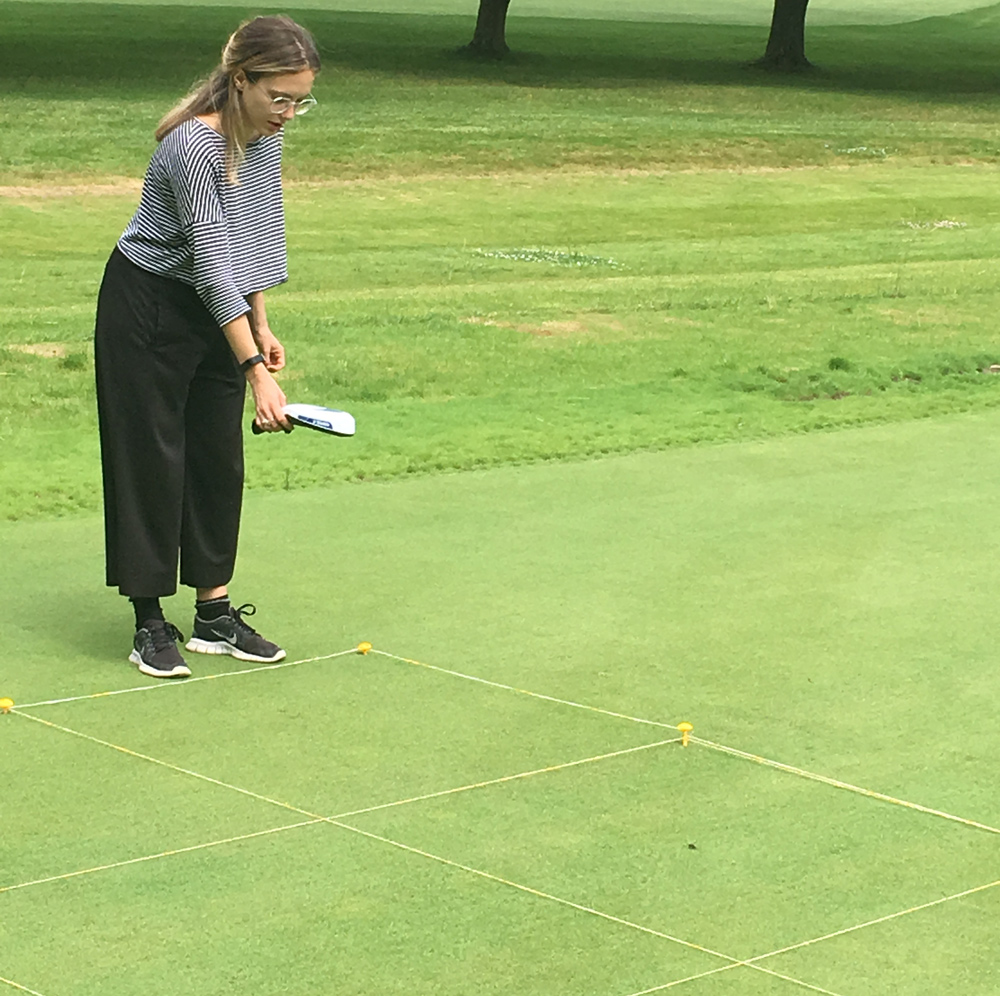Research on seaweeds for plant parasitic nematode management: Part 2
We recently caught up with Tamsin Williams to find out more how her PhD research has progressed. In this second part we focus also on other areas of her work.
A PhD encompasses a lot of work, were there other areas to highlight from outside the main-focus of Plant Parasitic Nematodes?
Tasmin: “Yes, I completed an industry questionnaire to highlight some issues which was interesting. It used an innovative system of ranking questions called Q-methodology so allowed modelling of responses – it showed turf industry people were broadly split into 3 groups which was fascinating. The three groups were ‘Solution-focused – negative thinkers’, ‘Progressive, positive thinkers’ and ‘Acquisition-centered traditionalists’. All groups identified the importance of finding sustainable management options, but these would be implemented at different key stages depending upon the group identity. There was generally a positive attitude towards biostimulant based management tools, but again the recognition of their importance in a management programme was different across the groups. It did come across that the industry would take on more sustainable approaches to management – if they can be clearly demonstrated to work and provide an acceptable level of surface performance. The Acquisition-centered traditionalists were generally more focused on surface performance in their answers. There was also a positive trend towards the requirement for more sustainable-centered research to help guide turf managers. The questionnaire provided some valuable and interesting insight and could be worth focusing on completely for a separate article.”
Really interesting, what else?
Tasmin: “There were a number of smaller scale research trials, within the main body of the PPN work. I think four of these would be of interest here.
1. I showed clearly that applications of alkaline extracted Ascophylum nodosum significantly increased plant rooting. This was very clear for Lolium perenne in particular. We also saw a change in root architecture with the same applications, more branching and more fibrous rooting. However, this was from pot-based trials, and care is always needed translating results from pot-based trials to an applied turf situation. For my field trials on mature turf – I did not measure significantly increased rooting – although there were trends towards greater root biomass. Measurement of rooting in the field is actually quite tricky to do consistently and robustly. It takes a lot of time, and care and I’m not sure the simplistic methodology sometimes employed is that reliable.
2. I also measured mycorrhizal root infection, and applications of alkaline extracted Ascophyllum nodosum significantly increased root infection by naturally occurring mycorrhizae, which was really positive. Better mycorrhizal infection should confer many benefits to the plant, certainly acquisition of some nutrients like phosphorus, and will help under droughting conditions. As an interesting point – we saw less benefit when a combination of commercial mycorrhizal powder and seaweed was applied. The seaweed seemed to work better and provide greater levels of infection with the natural mycorrhizae in the soil than with an applied mycorrhizal powder application which provided a lower rate of root infection – it would have been really nice to follow this up but is a prime example of not having time to follow every avenue of research and leaving some questions unanswered for future research to pick up.

3. One result that surprised me was that in the field trials I didn’t see any improved plant quality benefits, from applications of seaweed extract, in terms of better turf colour or turf growth, at least that I measured. However – all the trials were on well managed turf that received fertilisers and a good level of management, so perhaps this would have been difficult to separate out any plot-based responses coming just from the seaweed applications. Some existing research does show improved plant quality traits, such as crop yield – but Turfgrass can be a difficult crop to assess for quality.

4. I did some work on entomopathogenic nematodes. These are the ones that might be used to help manage insect larvae as pests in the rootzone. There is a species used to help manage chafer grubs and a species used to help manage leatherjackets in the turf. I wanted to check that seaweed applications had no effect if these applications overlapped. The results were very clear. I completed a serial dilution test – so starting with very dilute extract and doubling concentration in sequence. In each case I saw no ill-effect from the seaweed extract – these entomopathogenic nematodes stayed alive and were tested as viable. So clearly even at quite a strong concentration the seaweed extract is not having a direct control upon the live nematode.”
What did you miss from your thesis? Was there something more you wished you could have done?
Tasmin: “There are always unanswered questions and areas you would like to do more research. For me the Covid lockdowns meant I could not continue with more in-field research, it would have been great to have done another season of field trials on a more PPN susceptible site. Also, I could have looked in more detail at the relationship between seaweed applications and the rhizosphere microbiome, in terms of any changes to the environment and the biology there. That would have been really interesting, and I suspect really complicated.”

So what does the future hold? Some more turf research, I hope?
Tasmin: “Not quite, although I have really enjoyed the turf aspect to the research, and the opportunity of the research grant and the industrial support from ICL. I have recently accepted a position as Assistant Editor working for the Frontiers in Plant Science Journal. I will be working with the publication process for research papers in this area, something I am really looking forward to.”
Congratulations and good luck. Thanks for your time.


